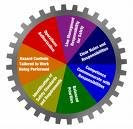
Effective safety and health management is about knowing how to identify and control hazards and applying key managerial principles so that employees work safety every day they're on the job.
BASIC SAFETY AND HEALTH MANAGEMENT PRINCIPLES
* Management commitments
* Training
* Accountability
* Employee involvement
* hazard identification and control
* Accident investigation
* Evaluation
MANAGEMENT COMMITMENT
Safety starts with commitment from the top managers must be committed to safety and health and hold supervisors accountable for enforcing safe practices.Examples that stress management commitments.
# A written safety and health policy that clearly states expectations for supervisors and employees.
# Identification and allocation of resources to achieve safety and health expectations.
# job descriptions that define safety and health responsibility,ensure employees understand that fulfilling those responsibilities is a condition of employment.
#Procedures to evalute's employees' safety performance and methods to correct unsafe work practices.
# A designated competent person to supervise employees.Hold supervisors accountable and responsible for enforcing safety and health rules and safe work practices.
TRAININGE
mployees should have orientation training that covers safety and health policies, safety rules and procedures for responding emergencies.Conduct new employee training before they begin works.train all employees before they are assigned to jobs that expose them to new hazards..A designated qualifies person must train employees at a level appropriate for their skills and in a language they can understand.Employees must be able to demonstrate correctly the safe practices associated with their job before they work alone.
ALL EMPLOYEES MUST KNOW
ALL EMPLOYEES MUST KNOW
1.How their assigned jobs safety
2.Safety and health hazards associated with their jobs and how to control the hazard.
3.Specific work procedure and safety requirements at the site.
4.How to use and maintain tools,equipment and machines requirements at site.
5.Safety and health rules that apply their jobs. Keep written records to each employees training that includes the employees name,the training date,the training received and the trainer..
ACCOUNTABILITY
All employees,including supervisors must have a clear understanding of the consequences for failing the perform their safety and health responsibilities.Strengthen accountability by doing the following.
* Develop and enforce a written disciplinary policy that has clear work place safety expectations for all employees.
* Hold supervisors responsible for developing proper attitudes for work place safety and health for enforcing safety and health rules, and for the safety record of those they supervise.
* Include employees safety and health responsibilities in their job descriptions and performance revolutions.Ensure that they understand fulfilling those responsibilities is a condition of employment. EMPLOYEE INVOLVEMENT
Safety cannot be managed effectively unless employees are involved in the day-to-day effort to keep the site safe.One of the best ways to get them involved is by having then attend safety meetings.their suggestion can help determine the resources necessary to achieve safety goals,develop training topics,identify hazards ans assist in programe development such as lockout-tagout procedures.
HAZARD IDENTIFICATION CONTROLCONDUCT A BASELINE SURVEY;
A baseline survey is a through evolution to the site-jobs, work practices,equipment and facilities-that identifies safety and health hazards.A complete survey tells you where the hazards are,what they are and how severe they could be.
PERFORM REGULAR SAFETY INSPECTORS
Baseline surveys are snapshots that tell you where hazards were when you surveyed.Regular inspections tell you whether you've controlled the hazards and help you identify new hazards.develop a procedure to ensure regular inspections.Designate competent persons to conduct the inspections.
Baseline surveys are snapshots that tell you where hazards were when you surveyed.Regular inspections tell you whether you've controlled the hazards and help you identify new hazards.develop a procedure to ensure regular inspections.Designate competent persons to conduct the inspections.
WATCH FOR HAZARDS
Watching for hazards is something that every one must do.Examples of what to watch for include;Unsafe work practices,missing equipment guards and poorly maintained or defective equipment.Require employees to report hazards immediatly to some one who has authority to act.
LOOK FOR NEW HAZARD WHENEVER YOU CHANGE EQUIPMENT,MATERIALS,OR WORK PROCESSES.
Asseses hazard that could result from the changes and determine how to control them.If your employees work at multiple sites you may need to do a hazard assesment at each site.Use material safety data sheets to identify chemical hazards.If employees handle hazards chemicals,develop a written hazard-communication plan that identifies the chemicals and describes how employees are informed about chemical hazards.employees must know how to use material safety data sheets(MSDS).A MSDS has detailed information about a hazardous chemical's health effects,physical and chemical characteristics,and safe practices for handling.Prepare a current hazardous chemical inventory list and have current MSDS for each hazardous chemical used.
KNOW WHEN AND HOW TO USR PERSONAL PROTECTIVE EQUIPMENT
Personal protective equipment is another way to control a hazard, but its only a barrier between the hazard and the user.If PPE fails, the user risks exposure.Before you purchase PPE,know the specific hazards it protects and against and be sure that it fits the user.Have an experienced safety professional help you when you're unsure especially when you're selecting chemical-protective clothing or respirators.Always train employes how to wear,use and maintain their equipment before they use it for the first time.
PRACTICE GOOD HOUSE KEEPING
Keep passage ways,store rooms and work areas clean.Keep electical cords away from areas where people could trip ovr them.Keep floors clean and dry,use drains,false floors,platforms or mats in wet areas.
Keep passage ways,store rooms and work areas clean.Keep electical cords away from areas where people could trip ovr them.Keep floors clean and dry,use drains,false floors,platforms or mats in wet areas.
PREPARE EMERGENCY RESPONSE PLAN
Any place of employment could have an emergency.work related,medical,or environmental.Have well stocked firstaid kits and a procedure for summoning ambulance or paramedic services.A well rehearsed emergency plan can protect lives,equipment and property.Business with more than 10 employees must put them plans in writing.For employees with 10 or fewer employees,the emergency plan does'nt have to be in writing.However employees must understand the plan so,they can respond promptly and appropriately an emergency.
MAINTAIN EQUIPMENT ON SCHEDULE
Preventive maintanance keep equioment running properly,reduces downtime and prevents accidents.Keep maintanace logs that show when the work was done,what was done,and the next schedule maintanance date.remove unsafe machines,tools or equipment from service and always follow manufacturer's maintanance requirements.
ACCIDENT INVESTIGATION
Almost all acidents are preventable and each one has a cause-por supervision,inadequate training or safety policies.eliminate the cause and accidents can be prevented.Dvelop accident investigation procedure and ensure that the investigation is though andaccurate.get statements from witnesses and other involved in the accident and prepare a report that describes hoe the accident can be prevented from happening again.discuss accident and near miss incidents with employees.
best regardsKHALEEL BATCHA T.Mdirector -coursesINSTITUTE SAFETY MANAGEMENT-CHENNAI(INDIA)(A DIVISION OF OSHA INDIA)




Comments :
0 komentar to “WHAT IS SAFETY AND HEALTH MANAGEMENT”
Posting Komentar